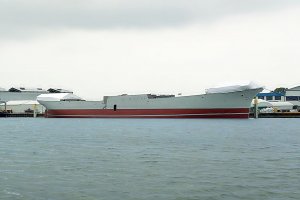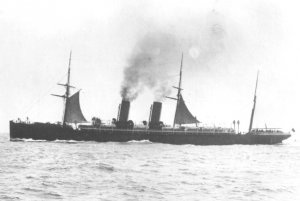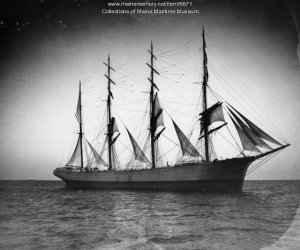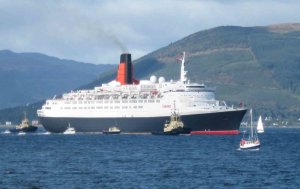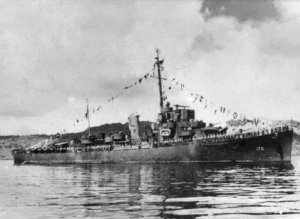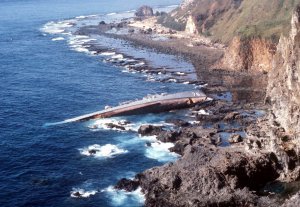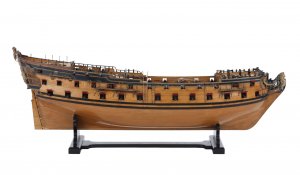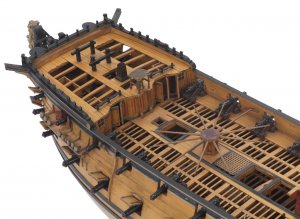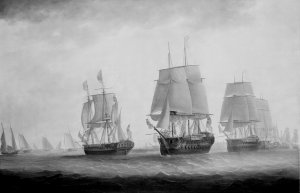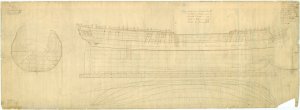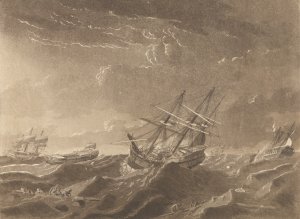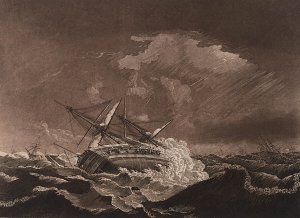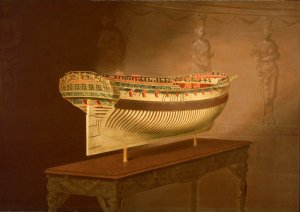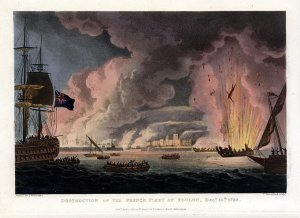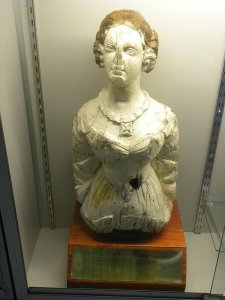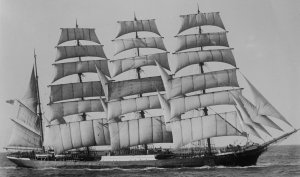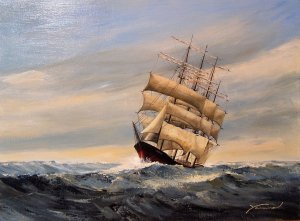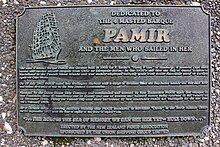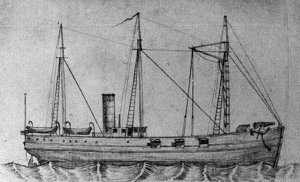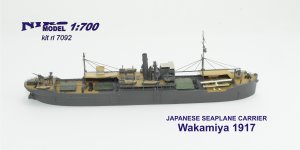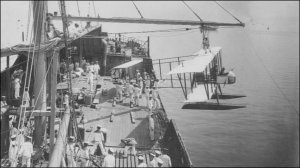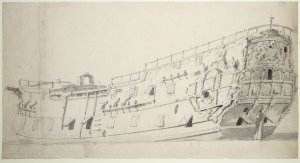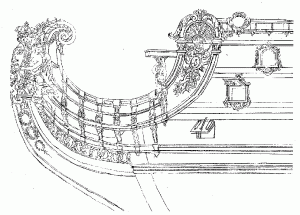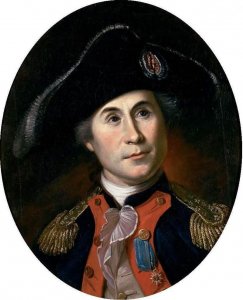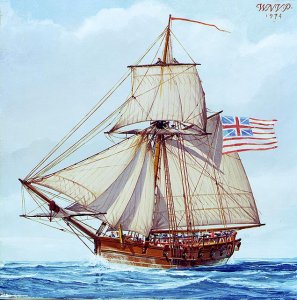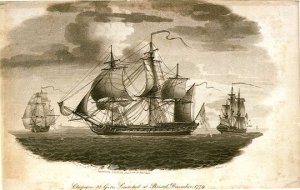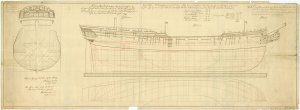Today in Naval History - Naval / Maritime Events in History
20 September 1911 – The White Star Line's RMS Olympic collides with the British warship HMS Hawke.
RMS Olympic (/ʊˈlɪmpɪk/) was a British transatlantic ocean liner, the lead ship of the White Star Line's trio of Olympic-class liners. Unlike the other ships in the class, Olympic had a long career spanning 24 years from 1911 to 1935. This included service as a troopship during the First World War, which gained her the nickname "Old Reliable". Olympic returned to civilian service after the war and served successfully as an ocean liner throughout the 1920s and into the first half of the 1930s, although increased competition, and the slump in trade during the Great Depression after 1930, made her operation increasingly unprofitable.

RMS Olympic during her sea trial
Olympic was the largest ocean liner in the world for two periods during 1911–13, interrupted only by the brief tenure of the slightly larger Titanic (which had the same dimensions but higher gross tonnage owing to revised interior configurations), before she was then surpassed by SS Imperator. Olympic also retained the title of the largest British-built liner until RMS Queen Mary was launched in 1934, interrupted only by the short careers of her slightly larger sister ships.
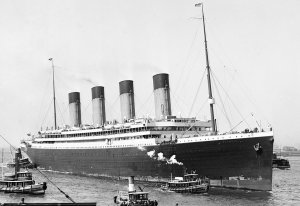
Olympic arriving at New York on her maiden voyage on 21 June 1911
The Olympic was withdrawn from service and sold for scrap in 1935; demolition was completed in 1937. Decorative elements of Olympic were removed and sold at auction before she was scrapped and now adorn buildings and a cruise ship.
By contrast with Olympic, the other two ships in the class, Titanic and Britannic, did not have long service lives. Titanic collided with an iceberg in the North Atlantic on its maiden voyage and sank, while Britannic struck a mine and sank in the Kea Channel in Greece in 1916.
Hawke collision

Images documenting the damage to Olympic (left) and Hawke (right) following their collision (other view here)
Olympic's first major mishap occurred on her fifth voyage on 20 September 1911, when she collided with the British cruiser HMS Hawke. The collision took place as Olympic and Hawke were running parallel to each other through the Solent. As Olympic turned to starboard, the wide radius of her turn took the commander of Hawke by surprise, and he was unable to take sufficient avoiding action. Hawke's bow, which had been designed to sink ships by ramming them, collided with Olympic's starboard side near the stern, tearing two large holes in Olympic's hull, above and below the waterline, resulting in the flooding of two of her watertight compartments and a twisted propeller shaft. Despite this, Olympic was able to return to Southampton under her own power; no one was seriously injured or killed. HMS Hawke suffered severe damage to her bow and nearly capsized; she was repaired, but sunk by the German U-boat SM U-9 in October 1914.
Captain Edward Smith was still in command of Olympic at the time of the incident. Two crew members, stewardess Violet Jessop and stoker Arthur John Priest, survived not only the collision with Hawke but also the later sinking of Titanic and the 1916 sinking of Britannic, the third ship of the class.
At the subsequent inquiry the Royal Navy blamed Olympic for the incident, alleging that her large displacement generated a suction that pulled Hawke into her side. The Hawke incident was a financial disaster for Olympic's operator. A legal argument ensued which decided that the blame for the incident lay with Olympic, and although the ship was technically under the control of the harbour pilot, the White Star Line was faced with large legal bills and the cost of repairing the ship, and keeping her out of revenue service made matters worse. However, the fact that Olympic endured such a serious collision and stayed afloat, appeared to vindicate the design of the Olympic-class liners and reinforced their "unsinkable" reputation.

Olympic (left) being manoeuvred into dry dock in Belfast for repairs on the morning of 2 March 1912 after throwing a propeller blade. Titanic(right) is moored at the fitting-out wharf. Olympic would sail for Southampton on 7 March, concluding the last time the two ships would be photographed together
It took two weeks for the damage to Olympic to be patched up sufficiently to allow her to return to Belfast for permanent repairs, which took just over six weeks to complete. To expedite repairs, Harland and Wolff was obliged to replace Olympic's damaged propeller shaft with one from Titanic, delaying the latter's completion. By 29 November Olympic was back in service, but, in February 1912, suffered another setback when she lost a propeller blade on an eastbound voyage from New York, and once again returned to her builder for repairs. To return her to service as soon as possible, Harland & Wolff again had to pull resources from Titanic, delaying her maiden voyage by three weeks, from 20 March to 10 April 1912.
HMS Hawke, launched in 1891, was the seventh British warship to be named Hawke. She was an Edgar-class protected cruiser.
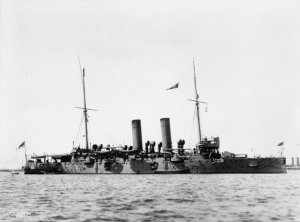
British Edgar class protected cruiser HMS HAWKE.
Construction
Hawke was laid down at Chatham Dockyard on 17 June 1889, one of nine Edgar-class cruisers ordered for the Royal Navy under the Naval Defence Act 1889, and launched on 11 March 1891. Sea trials in March 1892 were satisfactory, with her engines reaching the required power, and the ship was completed on 16 May 1893.
Hawke was 387 feet 6 inches (118.11 m) long overall and 360 feet (109.73 m) between perpendiculars, with a beam of 60 feet (18.29 m) and a draught of 23 feet 9 inches (7.24 m). She displaced 7,350 long tons(7,470 t).
Armament consisted of two 9.2 inch guns, on the ships centreline, backed up by ten six-inch guns, of which four were in casemates on the main deck and the remainder behind open shields. Twelve 6-pounder and four 3-pounder guns provided anti-torpedo-boat defences, while four 18 inch torpedo tubes were fitted. The Edgars were protected cruisers, with an arched, armoured deck 5–3 inches (127–76 mm) thick at about waterline level. The casemate armour was 6 inches (152 mm) thick, with 3 inches (76 mm) thick shields for the 9.2 inch guns and 10 inches (254 mm) armour on the ship's conning tower.
Hawke's machinery was built by Fairfields, with four double-ended cylindrical boilers feeding steam at 150 pounds per square inch (1,000 kPa) to 2 three-cylinder triple expansion engines, which drove two shafts. This gave 12,000 indicated horsepower (8,900 kW) under forced draught, giving a speed of 20 knots (37 km/h; 23 mph)
https://en.wikipedia.org/wiki/RMS_Olympic
https://en.wikipedia.org/wiki/HMS_Hawke_(1891)
20 September 1911 – The White Star Line's RMS Olympic collides with the British warship HMS Hawke.
RMS Olympic (/ʊˈlɪmpɪk/) was a British transatlantic ocean liner, the lead ship of the White Star Line's trio of Olympic-class liners. Unlike the other ships in the class, Olympic had a long career spanning 24 years from 1911 to 1935. This included service as a troopship during the First World War, which gained her the nickname "Old Reliable". Olympic returned to civilian service after the war and served successfully as an ocean liner throughout the 1920s and into the first half of the 1930s, although increased competition, and the slump in trade during the Great Depression after 1930, made her operation increasingly unprofitable.

RMS Olympic during her sea trial
Olympic was the largest ocean liner in the world for two periods during 1911–13, interrupted only by the brief tenure of the slightly larger Titanic (which had the same dimensions but higher gross tonnage owing to revised interior configurations), before she was then surpassed by SS Imperator. Olympic also retained the title of the largest British-built liner until RMS Queen Mary was launched in 1934, interrupted only by the short careers of her slightly larger sister ships.

Olympic arriving at New York on her maiden voyage on 21 June 1911
The Olympic was withdrawn from service and sold for scrap in 1935; demolition was completed in 1937. Decorative elements of Olympic were removed and sold at auction before she was scrapped and now adorn buildings and a cruise ship.
By contrast with Olympic, the other two ships in the class, Titanic and Britannic, did not have long service lives. Titanic collided with an iceberg in the North Atlantic on its maiden voyage and sank, while Britannic struck a mine and sank in the Kea Channel in Greece in 1916.
Hawke collision

Images documenting the damage to Olympic (left) and Hawke (right) following their collision (other view here)
Olympic's first major mishap occurred on her fifth voyage on 20 September 1911, when she collided with the British cruiser HMS Hawke. The collision took place as Olympic and Hawke were running parallel to each other through the Solent. As Olympic turned to starboard, the wide radius of her turn took the commander of Hawke by surprise, and he was unable to take sufficient avoiding action. Hawke's bow, which had been designed to sink ships by ramming them, collided with Olympic's starboard side near the stern, tearing two large holes in Olympic's hull, above and below the waterline, resulting in the flooding of two of her watertight compartments and a twisted propeller shaft. Despite this, Olympic was able to return to Southampton under her own power; no one was seriously injured or killed. HMS Hawke suffered severe damage to her bow and nearly capsized; she was repaired, but sunk by the German U-boat SM U-9 in October 1914.
Captain Edward Smith was still in command of Olympic at the time of the incident. Two crew members, stewardess Violet Jessop and stoker Arthur John Priest, survived not only the collision with Hawke but also the later sinking of Titanic and the 1916 sinking of Britannic, the third ship of the class.
At the subsequent inquiry the Royal Navy blamed Olympic for the incident, alleging that her large displacement generated a suction that pulled Hawke into her side. The Hawke incident was a financial disaster for Olympic's operator. A legal argument ensued which decided that the blame for the incident lay with Olympic, and although the ship was technically under the control of the harbour pilot, the White Star Line was faced with large legal bills and the cost of repairing the ship, and keeping her out of revenue service made matters worse. However, the fact that Olympic endured such a serious collision and stayed afloat, appeared to vindicate the design of the Olympic-class liners and reinforced their "unsinkable" reputation.

Olympic (left) being manoeuvred into dry dock in Belfast for repairs on the morning of 2 March 1912 after throwing a propeller blade. Titanic(right) is moored at the fitting-out wharf. Olympic would sail for Southampton on 7 March, concluding the last time the two ships would be photographed together
It took two weeks for the damage to Olympic to be patched up sufficiently to allow her to return to Belfast for permanent repairs, which took just over six weeks to complete. To expedite repairs, Harland and Wolff was obliged to replace Olympic's damaged propeller shaft with one from Titanic, delaying the latter's completion. By 29 November Olympic was back in service, but, in February 1912, suffered another setback when she lost a propeller blade on an eastbound voyage from New York, and once again returned to her builder for repairs. To return her to service as soon as possible, Harland & Wolff again had to pull resources from Titanic, delaying her maiden voyage by three weeks, from 20 March to 10 April 1912.
HMS Hawke, launched in 1891, was the seventh British warship to be named Hawke. She was an Edgar-class protected cruiser.

British Edgar class protected cruiser HMS HAWKE.
Construction
Hawke was laid down at Chatham Dockyard on 17 June 1889, one of nine Edgar-class cruisers ordered for the Royal Navy under the Naval Defence Act 1889, and launched on 11 March 1891. Sea trials in March 1892 were satisfactory, with her engines reaching the required power, and the ship was completed on 16 May 1893.
Hawke was 387 feet 6 inches (118.11 m) long overall and 360 feet (109.73 m) between perpendiculars, with a beam of 60 feet (18.29 m) and a draught of 23 feet 9 inches (7.24 m). She displaced 7,350 long tons(7,470 t).
Armament consisted of two 9.2 inch guns, on the ships centreline, backed up by ten six-inch guns, of which four were in casemates on the main deck and the remainder behind open shields. Twelve 6-pounder and four 3-pounder guns provided anti-torpedo-boat defences, while four 18 inch torpedo tubes were fitted. The Edgars were protected cruisers, with an arched, armoured deck 5–3 inches (127–76 mm) thick at about waterline level. The casemate armour was 6 inches (152 mm) thick, with 3 inches (76 mm) thick shields for the 9.2 inch guns and 10 inches (254 mm) armour on the ship's conning tower.
Hawke's machinery was built by Fairfields, with four double-ended cylindrical boilers feeding steam at 150 pounds per square inch (1,000 kPa) to 2 three-cylinder triple expansion engines, which drove two shafts. This gave 12,000 indicated horsepower (8,900 kW) under forced draught, giving a speed of 20 knots (37 km/h; 23 mph)
https://en.wikipedia.org/wiki/RMS_Olympic
https://en.wikipedia.org/wiki/HMS_Hawke_(1891)







